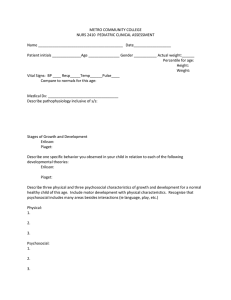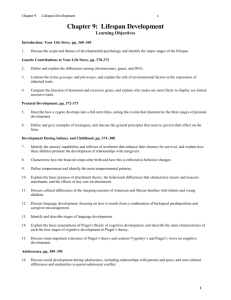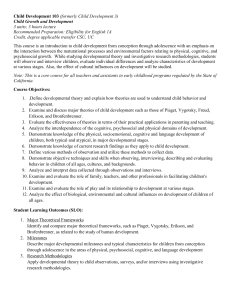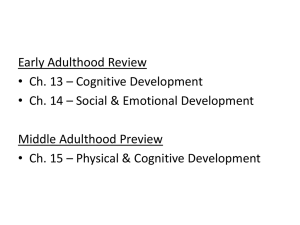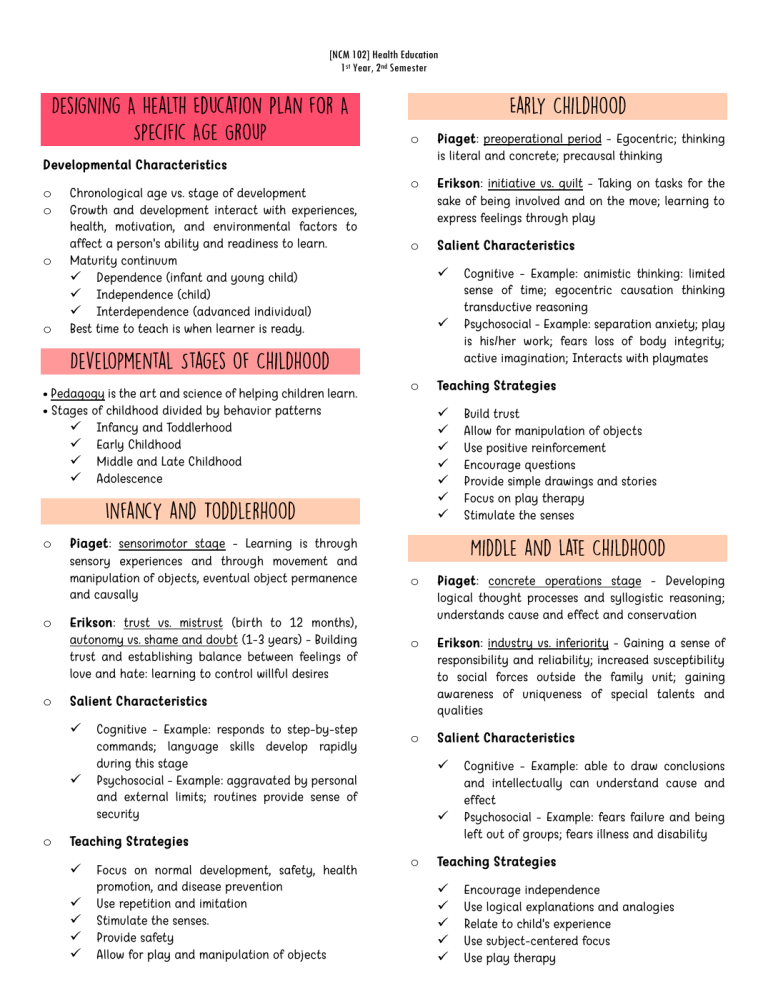
[NCM 102] Health Education 1st Year, 2nd Semester o Piaget: preoperational period - Egocentric; thinking is literal and concrete; precausal thinking o Erikson: initiative vs. guilt - Taking on tasks for the sake of being involved and on the move; learning to express feelings through play o Salient Characteristics Developmental Characteristics o o o o Chronological age vs. stage of development Growth and development interact with experiences, health, motivation, and environmental factors to affect a person's ability and readiness to learn. Maturity continuum ✓ Dependence (infant and young child) ✓ Independence (child) ✓ Interdependence (advanced individual) Best time to teach is when learner is ready. • Pedagogy is the art and science of helping children learn. • Stages of childhood divided by behavior patterns ✓ Infancy and Toddlerhood ✓ Early Childhood ✓ Middle and Late Childhood ✓ Adolescence o o o Piaget: sensorimotor stage - Learning is through sensory experiences and through movement and manipulation of objects, eventual object permanence and causally Erikson: trust vs. mistrust (birth to 12 months), autonomy vs. shame and doubt (1-3 years) - Building trust and establishing balance between feelings of love and hate: learning to control willful desires ✓ o ✓ Cognitive - Example: responds to step-by-step commands; language skills develop rapidly during this stage Psychosocial - Example: aggravated by personal and external limits; routines provide sense of security ✓ ✓ ✓ ✓ Focus on normal development, safety, health promotion, and disease prevention Use repetition and imitation Stimulate the senses. Provide safety Allow for play and manipulation of objects Build trust Allow for manipulation of objects Use positive reinforcement Encourage questions Provide simple drawings and stories Focus on play therapy Stimulate the senses o Piaget: concrete operations stage - Developing logical thought processes and syllogistic reasoning; understands cause and effect and conservation o Erikson: industry vs. inferiority - Gaining a sense of responsibility and reliability; increased susceptibility to social forces outside the family unit; gaining awareness of uniqueness of special talents and qualities o Salient Characteristics ✓ ✓ Teaching Strategies ✓ Cognitive - Example: animistic thinking: limited sense of time; egocentric causation thinking transductive reasoning Psychosocial - Example: separation anxiety; play is his/her work; fears loss of body integrity; active imagination; Interacts with playmates Teaching Strategies ✓ ✓ ✓ ✓ ✓ ✓ ✓ Salient Characteristics ✓ o ✓ o Cognitive - Example: able to draw conclusions and intellectually can understand cause and effect Psychosocial - Example: fears failure and being left out of groups; fears illness and disability Teaching Strategies ✓ ✓ ✓ ✓ ✓ Encourage independence Use logical explanations and analogies Relate to child's experience Use subject-centered focus Use play therapy [NCM 102] Health Education 1st Year, 2nd Semester ✓ ✓ o o o o Piaget: formal operations stage - Abstract thought; propositional reasoning; adolescent egocentrism (imaginary audience) Piaget: formal operations stage (begins in adolescence and carries through adulthood) Abstract thought; reasoning is both inductive and deductive o Erikson: identity vs. role confusion - Struggling to establish own identity; seeking independence and autonomy Erikson: intimacy vs. isolation - Focusing on relationships and commitment to others in their personal, occupational, and social lives o Salient Characteristics ✓ Salient Characteristics ✓ ✓ ▪ ▪ ▪ ▪ o Provide group activities Use drawings, models, dolls, painting, digital media, and computers Cognitive - Example: propositional thinking; complex logical reasoning; can build on past experiences; conceptualize the invisible Psychosocial Need for belonging to a group Need or personal space Example: personal fable — feels invulnerable, invincible/immune to natural laws example: imaginary audience intense personal preoccupation ✓ o ✓ ✓ ✓ ✓ ✓ ✓ ✓ ✓ ✓ Establish trust Identify control focus Use peers for support and influence Negotiate for change-contract Focus on details Make information meaningful to life. Ensure confidentiality and privacy Use role play, contracts, reading materials, and technology Allow for experimentation and flexibility within safe limits Teaching Strategies ✓ ✓ ✓ ✓ ✓ ✓ Teaching Strategies Piaget: formal operations stage - Abstract thought; reasoning is both inductive and deductive o Erikson: generativity vs. self-absorption and stagnation - Reflecting on accomplishments and determining if life changes are needed o Salient Characteristics o o ✓ Young Adulthood Middle-Aged Adulthood Older Adulthood Adulthood: Teaching & Learning Andragogy: the art and science of teaching adults Adult Learning Principles: relates learning to immediate needs; self-directed; teacher is facilitator; learner desires active role Use problem-centered focus Draw on meaningful experiences Focus on immediacy of application Allow for self-direction and setting own pace Organize material Encourage role play o ✓ o o o Cognitive - Example: cognitive capacity is fully developed but continuing to accumulate new knowledge and skills Psychosocial Example: autonomous; independent; stress related to the many decisions being made regarding career, marriage, parenthood. and higher education o Cognitive - Example: ability to learn remains steady Psychosocial - Example: facing issues with grown children, changes in own heath, and increased responsibility for own Parents Teaching Strategies ✓ ✓ ✓ Maintain independence and reestablish normal life patterns Assess positive and negative past learning experiences Assess potential sources of stress [NCM 102] Health Education 1st Year, 2nd Semester ✓ Provide information relative to life concerns and problems What is practice act? o Piaget: formal operations stage - Abstract thought; reasoning is both inductive and deductive o Erikson: ego integrity vs. despair - Coping with reality of aging, mortality, and reconciliation with past failures o Geragogy: the teaching of older persons, accommodating the normal physical, cognitive, and psychosocial changes o Salient Characteristics ✓ ▪ ▪ ✓ o Teaching Strategies ✓ ✓ ✓ ✓ ✓ ✓ ✓ ✓ ✓ ✓ ✓ ✓ ✓ ✓ o o o Cognitive Fluid intelligence - capacity to perceive relationships, to reason, and to perform abstract thinking, which declines with aging Crystallized intelligence - the intelligence absorbed over a lifetime, which increases with experience Psychosocial - Example: adjusting to changes in lifestyle and social status Use concrete examples Build on past experiences Focus on one concept at a time Use a slow pace Use repetition and reinforcement Provide brief explanations. Use analogies Speak slowly and clearly Use low-pitched tones Minimize distractions Rely on visual aids, and supplement with verbal instructions Use large letters and well-spaced print Provide a safe environment Give time to reminisce Family is one of the most important variables influencing patient outcomes The nurse educator and family should be allies It is important to choose the most appropriate caregiver to receive information Practice acts are documents that define a profession, describe that profession's scope of practice, and provide guidelines for state professional boards of nursing regarding standards for practice, entry into a profession via licensure, and disciplinary actions that can be taken when necessary Practice acts are developed to protect the public from unqualified practitioners and to protect the professional title, e.g., such as registered nurse (RN), occupational therapist (OT), respiratory therapist (RT), and physical therapist. What are the six ethical principles applied to patient education? 1. Autonomy - is derived from the Greek words "auto"(self) and "nomos" (law) and refers to the right of self-determination. Laws have been enacted to protect the patient's right to make choices independently. 2. Veracity -telling the truth, is closely lo informed decision making and informed consent. 3. Confidentiality - refers to personal information that is entrusted and protected as privileged information via a social contract, health care standard or code, or legal covenant. 4. Nonmaleficence - is defined as "do no harm" and refers to the ethics of legal determinations involving negligence and/or malpractice. 5. Beneficence of others - is defined as "doing good" for the benefit 6. Justice - speaks to fairness and the equitable distribution of goods and services. The law is the justice system [NCM 102] Health Education 1st Year, 2nd Semester o Student-Teacher Relationship o o o o Students and teachers have their own perspectives, visions, values, and preferences that are known to each other They must be negotiated and understood by each party for the process of education to proceed with trust and respect. A balance of power exists between the teacher (expert) and the student (novice]. The teacher possesses discipline-specific expertise, which is key to the student's academic success, career achievement, and competent care of patients. Students must be able to trust their teachers-even instantaneously-and believe that the instruction provided by them will be accurate, appropriate, and up to date. students are autonomous agents Patient-Provider Relationship o o o o o o Nurses (and nursing students) and the patients they care for also have their own worldviews that come together in the practice setting These perspectives must be negotiated and understood by each party for the process of patient education to occur with a sense of trust. As with the student-teacher relationship, it is important to recognize the balance of power that exists between a nurse-even a nursing student-and a patient. The blurring of professional boundaries is also an area of ethical importance common to nurse' (or 'nursing students') relationships with their patients. Are tied to licensure, state and federal laws, scope of practice and a public expectation that nurses practice at a high professional standard. The nurse's education, license and nursing standard provide the framework by which nurses are expected to practice. When a nurse's practice falls below acceptable standards of care and competence, this exposes the nurse to litigation. The basis for litigation can relate to negligence, railing to exercise the level of care that a reasonable, prudent nurse would under similar o o circumstances; malpractice; and professional negligence, which means an act of neglect committed in the nurse's professional role. Acts of omission and commission will also subject the nurse to litigation and professional license review. Both litigation and professional license review can result in reprimand of a nurse's license or loss of a license. Poor or inaccurate documentation, significant financial losses can result from missed notation. The patient's right to adequate information regarding his or her physical condition, medications, risks, and access to information regarding alternative treatments is specifically spelled out in the revised edition of a Patient's Bill of Rights. In addition, state regulations pertaining to patient education are published and enforced under threat of penalty by the department of health in many states. Physicians are responsible and accountable for proper patient education.
